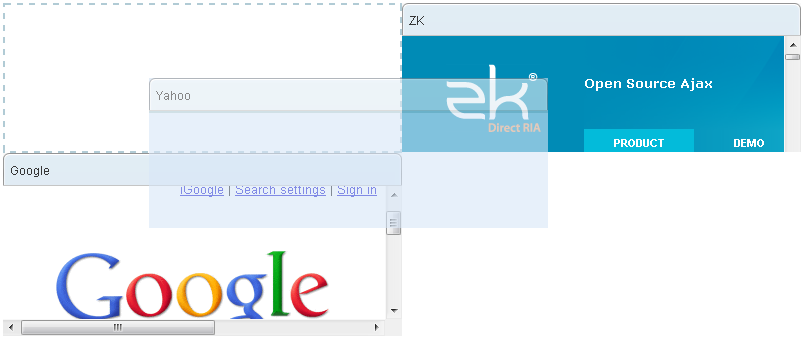Portallayout"
From Documentation
m (→Portallayout) |
m |
||
| Line 6: | Line 6: | ||
*Java API: <javadoc>org.zkoss.zkmax.zul.Portallayout</javadoc> | *Java API: <javadoc>org.zkoss.zkmax.zul.Portallayout</javadoc> | ||
*JavaScript API: <javadoc directory="jsdoc">zkmax.layout.Portallayout</javadoc> | *JavaScript API: <javadoc directory="jsdoc">zkmax.layout.Portallayout</javadoc> | ||
| − | *Style Guide: [ | + | *Style Guide: [[ZK_Style_Guide/XUL_Component_Specification/Portallayout| Portallayout]] |
*{{ZK EE}} | *{{ZK EE}} | ||
Revision as of 09:33, 19 January 2011
Portallayout
- Demonstration: Portallayout
- Java API: Portallayout
- JavaScript API: Portallayout
- Style Guide: Portallayout
- Available for ZK:
-

Employment/Purpose
A portallayout lays out a container which can have multiple columns, and each column might have any number panels placed vertically with different heights. Portallayout allows the user to drag-and-drop a panel to change its location.
When using Portallayout, you have to assign the width (either present or pixel) to each Portalchildren, or the result might depend on the browser, and not as expected.
Example
<portallayout>
<portalchildren width="50%">
<panel height="150px" title="Yahoo">
<panelchildren>
<iframe width="100%" src="http://www.yahoo.com/"/>
</panelchildren>
</panel>
<panel height="300px" title="Google">
<panelchildren>
<iframe width="100%" src="http://www.google.com/"/>
</panelchildren>
</panel>
</portalchildren>
<portalchildren width="50%">
<panel height="150px" title="ZK">
<panelchildren>
<iframe width="100%" src="http://www.zkoss.org/"/>
</panelchildren>
</panel>
</portalchildren>
</portallayout>
Supported Events
| Event: PortalMoveEvent
Represents an event caused by a portal being moved. |
- Inherited Supported Events: XulElement
Supported Children
* Portalchildren
Use Cases
| Version | Description | Example Location |
|---|---|---|
Version History
| Version | Date | Content |
|---|---|---|
